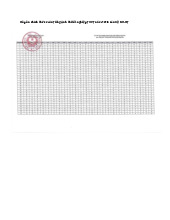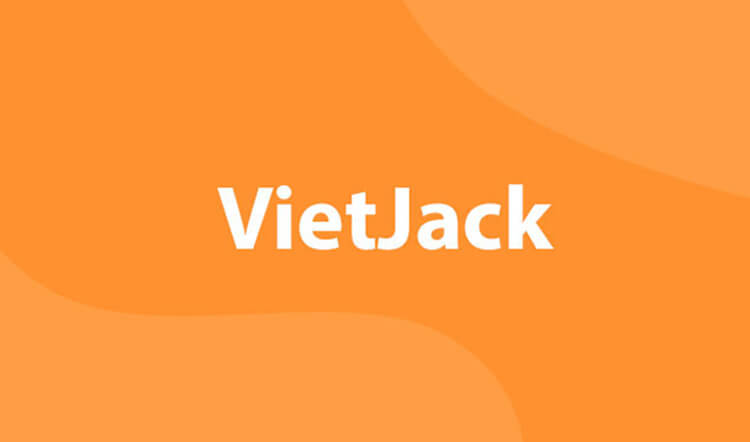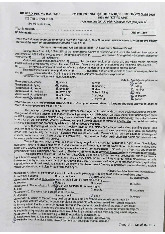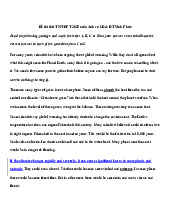











Preview text:
Read the following advertisement and mark the letter A, B, C or D on your answer sheet to
indicate the correct option that best fits each of the numbered blanks from 1 to 6.
Super Typhoon Milton and its Destruction
Super Typhoon Milton struck the eastern coastline last weekend, causing widespread devastation.
Many residents described it as the most (1) _________ experience they had ever faced. The
combination of (2) _________ and relentless rain left the town completely paralyzed.
The typhoon, (3) _________ the coast at around 3 PM, brought winds exceeding 180 km/h. This
resulted in massive flooding and left thousands (4) _________ need of emergency assistance. The
authorities worked hard to (5) _________ a difference, but the sheer scale of the disaster made recovery efforts slow.
Now, the community is slowly rebuilding their homes, hoping _________ (6) what was lost. 1. A. terrifying B. terrified C. terrifies D. terrify 2. A. strong stormy winds B. winds strong stormy C. stormy strong winds D. stormy winds strong 3. A. which hits B. hitting C. that hits D. hit 4. A. in B. at C. on D. with 5. A. make B. take C. do D. have 6. A. to be restored B. restoring C. to restore D. being restored
Read the following leaflet and mark the letter A, B, C or D on your answer sheet to indicate the
correct option that best fits each of the numbered blanks from 7 to 12.
Students born in 2007 have just received the university entrance mock exam issued by the
Ministry of Education. The exam, which is reportedly shorter and more difficult than previous years,
has left many (7) _________ feeling anxious. The questions are mainly focused on reading
comprehension and vocabulary, requiring students to (8) _________ complex words and phrases.
Teachers have acknowledged that this is a (9) _________ exam, but they believe it has the
potential to accurately classify students based on their abilities. (10) _________ the increased
difficulty, the exam is considered fair and capable of assessing the students’ true competencies.
Despite the pressure, the (11) _________ of students sitting for the exam remains high. With a
focus on reading comprehension, the exam is expected to test the (12) _________ of students'
preparedness for the university entrance process. 7. A. another B. others C. other D. the other 8. A. figure out B. look for C. take in D. give up 9. A. challenging B. relaxing C. simple D. boring 10. A. Instead of
B. On account of C. Irrespective of D. In view of 11. A. number B. amount C. quantity D. level 12. A. accuracy B. width C. depth D. randomness
Mark the letter A, B, C, or D on your answer sheet to indicate the correct arrangement of the
sentences to make a meaningful exchange or text in each of the following questions. 13. a.
Alice: "That sounds serious. Have you been to see a doctor?" b.
Mark: "Not great, actually. I've been feeling under the weather for a few days." c.
Alice: "How have you been, Mark?" A. c – a – b B. b – c – a C. c – b – a D. a – c – b 14. a.
John: I’m planning to visit Japan next summer. b. Mary: Why Japan? c.
Mary: Have you already decided on the places you want to visit? d.
John: I’ve always been fascinated by Japanese culture and history. e.
Mary: That sounds amazing! I hope you enjoy the trip. A. c-a-b-d-e B. a-b-d-c-e C. b-a-e-d-c D. c-a-d-b-e 15.
a. Besides, doing chores together can actually be fun and it makes the work go faster.
b. Dear Mike, I hope you are well! I've been thinking about why it's important for
children to help with housework.
c. It's a good way for families to spend time together and learn new skills.
d. Firstly, it teaches us responsibility and how to take care of our own things.
e. Also, when we help our parents, it shows them respect and gratitude for all they do for us. f. Best wishes. A. b-c-a-e-d-f B. b-d-e-a-c-f C. b-a-d-e-c-f D. b-e-d-a-c-f 16. aBesides, I excel in my classes, consistently achieving high scores.
b. I'm a responsible high school student looking for a part-time job that will allow me to gain valuable experience.
c. I can manage my time effectively and always meet deadlines both at school and in any jobs I take on.
d. But academics aren't my only strength – I'm also really organized.
e. I believe I have great teamwork skills as I'm always happy to work with others and
contribute my ideas to achieve a common goal. A. b-c-e-d-a B. b-a-e-d-c C. b-e-a-d-c D. b-d-c-a-e 17. a. It started off perfectly, exceeding even my wildest dreams.
b. We felt anxious and disappointed when all the tours were canceled and flights were delayed.
c. However, on the fourth day, my experience took an unexpected turn when the city was hit by a severe rainstorm.
d. My trip to Dubai in April 2024 was supposed to be a dream vacation with luxurious hotels and desert safaris.
e. Although the floods meant we were stuck in the hotel, it turned out to be a blessing in
disguise as we formed unexpected friendships with other tourists. A. d-c-a-b-e B. d-a-b-c-e C. d-e-a-b-c D. d-a-c-b-e
Read the following passage about humanoid robots and mark the letter A, B, C or D on your
answer sheet to indicate the option that best fits each of the numbered blanks from 18 to 22.
In recent years, artificial intelligence (AI) has been widely applied in various fields, including
healthcare, finance, and education. AI systems are now (18) _______. Despite these advancements,
there are still concerns about the ethical use of AI, particularly in (19) _______.
Many organizations are adopting AI technologies (20) _______. These technologies have the
potential to transform industries, but experts emphasize that AI should complement human abilities
rather than replace them. For example, in education, AI can (21) _______, allowing teachers to focus
on other important aspects of teaching. However, it remains crucial to ensure that AI (22) _______. 18. A.
being integrating into critical industries that handle complex decision – making processes B.
integrated in workflows where human input is gradually becoming unnecessary C.
being integrated into systems designed to automate repetitive and data – driven tasks D.
being integrate into systems which still depend on human supervision 19. A.
making decisions which traditionally relied on human expertise B.
to make decisions that required careful consideration and judgment C.
making of decisions that influence significant outcomes in various sectors D.
make decisions in situations that require ethical responsibility 20. A.
with aim improve processes and increase productivity B.
in order improving operations across various departments C.
in order to improve efficiency and reduce human mistakes
D. with the goal of to enhancing performance and minimizing errors 21. A.
helps performing automated grading and feedback tasks B.
be applied to doing various tasks in educational settings C.
perform tasks like grading and giving feedback for students D.
performs tasks to providing real – time feedback to students 22. A.
operates in a manner which respects human oversight B.
operate with consistent regulations to guarantee fairness C.
operates consistently to ensure that ethical standards are met D.
are operating according to principles of fairness and transparency
Read the following passage and mark the letter A, B, C or D on your answer sheet to indicate
the option that best fits each of the numbered blanks.
Urbanization refers to the process through which cities grow and expand as more people move
from rural to urban areas. This phenomenon is driven by various factors, including economic
opportunities, educational facilities, and healthcare services, which often attract individuals seeking
better living standards. As cities become more populated, they undergo significant transformations in
infrastructure, including housing, transportation, and public services.
The rise in urban populations can lead to both positive and negative outcomes. On the positive
side, urbanization can stimulate economic development, innovation, and cultural exchange. It often
brings improvements in living standards and provides better access to services and amenities.
However, rapid urban growth can also strain existing infrastructure, leading to issues such as
overcrowding, pollution, and inadequate public services. These challenges can impact the quality of
life in urban areas and require careful planning and management.
Effective urban planning is crucial to mitigating the negative effects of urbanization. This
includes creating sustainable infrastructure, managing resources efficiently, and ensuring equitable
access to services for all residents. By addressing these challenges, cities can harness the benefits of
urbanization while improving the overall quality of urban life.
[Adapted from United Nations. "World Urbanization Prospects: The 2018 Revision." United Nations
Department of Economic and Social Affairs, Population Division, 2019] 23.
Which of the following is NOT mentioned as a factor driving urbanization?
A. Economic opportunities B. Healthcare services C. Climate change
D. Educational facilities 24.
The word “stimulate” in paragraph 2 is OPPOSITE in meaning to ______. A. encourage B. promote C. hinder D. accelerate 25.
The word “they” in paragraph 1 refers to ______. A. rural areas B. cities
C. economic opportunities D. suburban 26.
The word “mitigating” in paragraph 3 could best be replaced by ______. A. worsening B. addressing C. preventing D. reducing 27.
Which of the following best paraphrases the underlined sentence in paragraph 3? A.
Good urban planning is essential to address urbanization’s adverse effects. B.
Proper urban planning can help reduce the negative impacts of urban growth. C.
Mitigating urbanization’s drawbacks requires effective urban planning. D.
Managing urbanization’s negative consequences relies on strategic urban planning. 28.
According to the passage, which of the following is TRUE? A.
Urbanization always improves living standards. B.
Rapid urbanization can lead to overcrowding and pollution. C.
Economic development is rarely associated with urbanization. D.
Urban growth only brings negative outcomes. 29.
In which paragraph does the writer mention the benefits of urbanization? A. Paragraph 1 B. Paragraph 2 C. Paragraph 3 D. Paragraph 4 30.
In which passage does the author mention that durable infrastructure helps
manage the impacts of urbanization? A. Paragraph 1 B. Paragraph 2 C. Paragraph 3 D. Paragraph 4
Read the following passage about the urban shift and mark the letter A, B, C or D on your
answer sheet to indicate the best answer to each of the following questions from 31 to 40.
[I] Landslides are a significant environmental challenge in the northern mountainous provinces of
Vietnam, particularly during the rainy season. The region, characterized by steep slopes and heavy
rainfall, is prone to this natural disaster, which poses serious threats to both the local population and
infrastructure. [II] In recent years, numerous landslides have occurred, often triggered by prolonged
periods of heavy rain, resulting in devastating impacts on communities and livelihoods.
The mountainous terrain, combined with deforestation and improper land use, exacerbates the
risk of landslides. [III] As farmers clear forests for agriculture, the natural vegetation that stabilizes
the soil is lost, making slopes more susceptible to erosion. When heavy rains saturate the soil, it can
quickly become unstable, leading to sudden and destructive landslides. [IV]
In response to this growing threat, local authorities and environmental organizations are taking
proactive measures to mitigate the risks associated with landslides. Efforts include reforestation
projects, improving drainage systems, and raising public awareness about safe practices during the
rainy season. Additionally, advanced monitoring systems are being implemented to provide early
warnings, allowing communities to evacuate before a disaster strikes.
Despite these efforts, the challenges remain significant, and ongoing education and support for
sustainable land management practices are crucial for reducing the incidence and impact of landslides in northern Vietnam. 31.
Where in this passage does the following sentence best fit?
These events not only destroy homes and roads but also disrupt essential services such as
education and healthcare. A. [I] B. [II] C. [III] D. [IV] 32.
The word “prone” in paragraph 1 could be best replaced by_________. A. resistant B. vulnerable C. indifferent D. immune 33.
The word “it” in paragraph 2 refers to ________. A. the soil B. the rainy season C. the local population D. the infrastructure 34.
According to paragraph 3, which of the following is NOT a proactive
measure to mitigate the risks associated with landslides?
A. Reforestation projects
B. Improving drainage systems
C. Increasing logging activities
D. Raising public awareness 35.
Which of the following best summarises paragraph 3? A.
Local authorities and organizations are actively working to reduce the risks of
landslides through various projects and public education initiatives. B.
The government is focusing on implementing advanced technologies to
predict landslides and ensure the safety of local communities. C.
Reforestation and improved drainage systems are essential for enhancing the
environment and preventing landslides in northern Vietnam. D.
Communities are encouraged to participate in disaster preparedness training
to minimize the impact of landslides during the rainy season. 36.
The phrase “susceptible to” in paragraph 3 is OPPOSITE in meaning to________. A. open to B. immune to C. prone to D. favorable for 37.
Which of the following is TRUE according to the passage? A.
Landslides only occur in the rainy season. B.
The local population is unaffected by landslides. C.
Deforestation contributes to landslide risks. D.
Monitoring systems are unnecessary for landslide management. 38.
Which of the following best paraphrases the underlined part in paragraph 4? A.
Even with these initiatives, the difficulties continue to be considerable. B.
Although these measures have been taken, the challenges are still manageable. C.
In spite of these actions, the obstacles still appear to be minor. D.
Regardless of these efforts, the challenges areconsidered easy to overcome. 39.
Which of the following can be inferred from the passage? A.
Ongoing reforestation and improved land management practices are essential
for minimizing future landslide risks in northern Vietnam. B.
The frequency of landslides in northern Vietnam will likely decrease in the
coming years due to effective government interventions. C.
Local communities are fully aware of the risks of landslides and are actively
participating in mitigation efforts. D.
Climate change is the sole cause of the increasing landslide occurrences in
the northern mountainous provinces of Vietnam. 40.
Which of the following best summarises the passage? A.
Landslides are a minor issue in northern Vietnam. B.
The effects of landslides are temporary and easily managed. C.
Landslides pose a significant threat, but measures are being taken to reduce their impact. D.
Local authorities have completely eliminated the risk of landslides. ĐÁP ÁN 1. A 11. A 21. C 31. D 2. A 12. C 22. C 32. B 3. B 13. C 23. C 33. A 4. A 14. A 24. C 34. C 5. A 15. B 25. B 35. A 6. C 16. C 26. D 36. B 7. B 17. D 27. B 37. C 8. A 18. C 28. B 38. A 9. A 19. A 29. B 39. B 10. B 20. C 30. C 40. C




